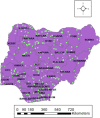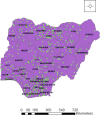Bayesian spatio-temporal modelling and mapping of malaria and anaemia among children between 0 and 59 months in Nigeria
- PMID: 36320061
- PMCID: PMC9623970
- DOI: 10.1186/s12936-022-04319-y
Bayesian spatio-temporal modelling and mapping of malaria and anaemia among children between 0 and 59 months in Nigeria
Abstract
Background/m&m: A vital aspect of disease management and policy making lies in the understanding of the universal distribution of diseases. Nevertheless, due to differences all-over host groups and space-time outbreak activities, data are subject to intricacies. Herein, Bayesian spatio-temporal models were proposed to model and map malaria and anaemia risk ratio in space and time as well as to ascertain risk factors related to these diseases and the most endemic states in Nigeria. Parameter estimation was performed by employing the R-integrated nested Laplace approximation (INLA) package and Deviance Information Criteria were applied to select the best model.
Results: In malaria, model 7 which basically suggests that previous trend of an event cannot account for future trend i.e., Interaction with one random time effect (random walk) has the least deviance. On the other hand, model 6 assumes that previous event can be used to predict future event i.e., (Interaction with one random time effect (ar1)) gave the least deviance in anaemia.
Discussion: For malaria and anaemia, models 7 and 6 were selected to model and map these diseases in Nigeria, because these models have the capacity to receive strength from adjacent states, in a manner that neighbouring states have the same risk. Changes in risk and clustering with a high record of these diseases among states in Nigeria was observed. However, despite these changes, the total risk of malaria and anaemia for 2010 and 2015 was unaffected.
Conclusion: Notwithstanding the methods applied, this study will be valuable to the advancement of a spatio-temporal approach for analyzing malaria and anaemia risk in Nigeria.
Keywords: Bayesian Hierarchical; Deviance Information Criteria; Heterogeneity; Risk Ratio and R-integrated nested Laplace approximation (INLA); Spatio-temporal.
© 2022. The Author(s).
Conflict of interest statement
The authors do declare that there is no competing interest.
Figures








Similar articles
-
Spatial variation and risk factors of malaria and anaemia among children aged 0 to 59 months: a cross-sectional study of 2010 and 2015 datasets.Sci Rep. 2022 Jul 7;12(1):11498. doi: 10.1038/s41598-022-15561-4. Sci Rep. 2022. PMID: 35798952 Free PMC article.
-
Estimation of malaria incidence in northern Namibia in 2009 using Bayesian conditional-autoregressive spatial-temporal models.Spat Spatiotemporal Epidemiol. 2013 Dec;7:25-36. doi: 10.1016/j.sste.2013.09.001. Epub 2013 Sep 17. Spat Spatiotemporal Epidemiol. 2013. PMID: 24238079 Free PMC article.
-
Joint spatiotemporal modelling of tuberculosis and human immunodeficiency virus in Ethiopia using a Bayesian hierarchical approach.BMC Public Health. 2025 Jan 30;25(1):377. doi: 10.1186/s12889-024-20996-7. BMC Public Health. 2025. PMID: 39885478 Free PMC article.
-
Spatial and spatio-temporal models with R-INLA.Spat Spatiotemporal Epidemiol. 2013 Dec;7:39-55. doi: 10.1016/j.sste.2013.07.003. Spat Spatiotemporal Epidemiol. 2013. PMID: 24377114 Review.
-
Spatial and spatio-temporal models with R-INLA.Spat Spatiotemporal Epidemiol. 2013 Mar;4:33-49. doi: 10.1016/j.sste.2012.12.001. Epub 2013 Jan 2. Spat Spatiotemporal Epidemiol. 2013. PMID: 23481252 Review.
Cited by
-
Optimizing spatio-temporal correlation structures for modeling food security in Africa: a simulation-based investigation.BMC Bioinformatics. 2024 Apr 27;25(1):168. doi: 10.1186/s12859-024-05791-w. BMC Bioinformatics. 2024. PMID: 38678218 Free PMC article.
-
Interactive and lag effects of environmental factors on the density of schistosome-transmitting Oncomelania hupensis: A twelve-year monthly repeated survey.Parasitol Res. 2024 Aug 16;123(8):301. doi: 10.1007/s00436-024-08323-w. Parasitol Res. 2024. PMID: 39150558
-
Three Gorges Dam: Potential differential drivers and trend in the spatio-temporal evolution of the change in snail density based on a Bayesian spatial-temporal model and 5-year longitudinal study.Parasit Vectors. 2023 Jul 14;16(1):232. doi: 10.1186/s13071-023-05846-6. Parasit Vectors. 2023. PMID: 37452398 Free PMC article.
-
Modelling spatiotemporal patterns of visceral leishmaniasis incidence in two endemic states in India using environment, bioclimatic and demographic data, 2013-2022.PLoS Negl Trop Dis. 2024 Feb 5;18(2):e0011946. doi: 10.1371/journal.pntd.0011946. eCollection 2024 Feb. PLoS Negl Trop Dis. 2024. PMID: 38315725 Free PMC article.
-
Integrating vulnerability and hazard in malaria risk mapping: the elimination context of Senegal.BMC Infect Dis. 2025 Aug 18;25(1):1031. doi: 10.1186/s12879-025-11412-5. BMC Infect Dis. 2025. PMID: 40826047 Free PMC article.
References
-
- WHO . World malaria report 2021. Geneva: World Health Organization; 2021.
-
- Ahmad F, Goparaju L, Qayum A. Studying malaria epidemic for vulnerability zones: multi-criteria approach of geospatial tools. J Geosci Environ Protect. 2017;5:30–53. doi: 10.4236/gep.2017.55003. - DOI
MeSH terms
LinkOut - more resources
Full Text Sources
Medical

